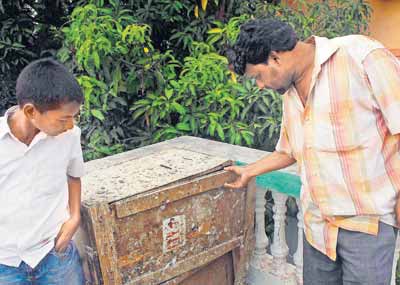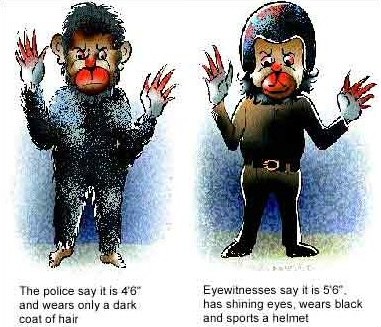Bhootbilli, India’s Ghost Cat, Strikes Again
Posted by: Loren Coleman on November 8th, 2010

The spot (above) from where pigeons were picked up by the creature; Feroze Khan shows the box in which he kept his pigeons. Photo: Mid-Day.
In North America, they might be called Mystery Cats or Phantom Panthers, but the Bhootbilli, The Ghost Cat of India, seems to inhabit a similar location in that country’s mentality.

This report issues from a place called Pune, India. The name Pune derives from Punya Nagari (Sanskrit, “City of Virtue”). It is a relatively hilly city, with its tallest hill, Vetal Hill, rising to 800 m (2,600 ft) above sea level. Central Pune is located at the confluence of the Mula and Mutha rivers. Pune (Marathi: पुणे, pronounced [puɳeː]), formerly called Poona, also known as Punya-Nagari, is the eighth largest metropolis in India, the second largest in the state of Maharashtra, after Mumbai and the largest city in the Western Ghats. Pune has a tropical wet and dry climate with average temperatures ranging between 68 to 82 °F (20 to 28 °C).

This report is passed along to me by Chad Arment, the author of the new book, Varmints: Mystery Carnivores of North America, and his recent classic, Boss Snakes: Stories and Sightings of Giant Snakes in North America.
A “weird, scary creature” has been giving residents of Sanjay Park area sleepless nights. Those staying near the airport in Lohegaon are complaining about a Bhootbilli (ghost cat), which they say has been feeding on domestic animals and birds the past 10 days.
For several people, the incident brought to mind the monkey-man episode, a ‘monster’ that was reportedly roaming around Delhi in 2001 (see here).
“The Bhootbilli has been coming everyday the past 10 days around 7 pm. We had set up a lot of traps, but all turned into a flop show because whenever we would try to catch it, it would jump on the tree and sneak out somewhere,” said Feroz Dilawar Khan, a driver and resident of the area. “It’s fat and broad with a long tail, black in colour, has a face like a dog and back like a mongoose.”
The Bhootbilli, as it is called by the residents, has eaten around 45 pigeons and one goat within a span of 10 days which all belonged to Feroz.
Fed-up of the creature, Feroz called the police, fire brigade and forest officials on November 3 around 10 pm, but the effort went in vain. “We arrived at the spot around 10 pm, but the animal had already escaped and hid somewhere in the trees,” said one of the fire officials from Yerawada, who was at the spot.
The residents have again set a trap and are expecting to catch the mischief-maker this time. Hrishikesh Sutar, chairman of the Sanjay Park Society, said: “The residents came complaining to me around four days ago and we haven’t yet identified the creature. It’s smaller than a lion but bigger than a hyena and I doubt if it’s a wild cat.”
What could it be?
Shekhar Nanajkar, president of a Wild, a wildlife organisation, said: “It’s a rare case but according to the description given to me it can be a civet cat who attacks only small animals and birds. But if a goat has been eaten then it’s either a leopard or human being.”
Anil Avchite, an animal lover, who had gone to the area around midnight on Wednesday, said: “I climbed up a 40-feet coconut tree as soon as the locals contacted me. I am sure it’s a civet cat. I have asked locals to get in touch with me if they see the creature again.”
Also, attached to the article are these definitions:
Delhi’s monkey-man
A strange, monkey-like creature had been appearing at night and attacking people in Delhi in 2001. Many thought a man dressed as a monkey was intimidating people, but he was never caught
The civet cat
A civet is a small, lithe-bodied, mostly arboreal mammal native to the tropics of Africa and Asia. Civets have a broadly cat-like general appearance, though the muzzle is extended and often pointed, rather like an otter or a mongoose
Source: “Bhootbilli on the prowl / Lohegaon residents say at 7 pm every day, elusive cat-dog-mongoose creature comes to eat their pigeons, goats” by Preeti Agarwal, November 5, 2010.
About Loren Coleman
Loren Coleman is one of the world’s leading cryptozoologists, some say “the” leading living cryptozoologist. Certainly, he is acknowledged as the current living American researcher and writer who has most popularized cryptozoology in the late 20th and early 21st centuries.
Starting his fieldwork and investigations in 1960, after traveling and trekking extensively in pursuit of cryptozoological mysteries, Coleman began writing to share his experiences in 1969. An honorary member of Ivan T. Sanderson’s Society for the Investigation of the Unexplained in the 1970s, Coleman has been bestowed with similar honorary memberships of the North Idaho College Cryptozoology Club in 1983, and in subsequent years, that of the British Columbia Scientific Cryptozoology Club, CryptoSafari International, and other international organizations. He was also a Life Member and Benefactor of the International Society of Cryptozoology (now-defunct).
Loren Coleman’s daily blog, as a member of the Cryptomundo Team, served as an ongoing avenue of communication for the ever-growing body of cryptozoo news from 2005 through 2013. He returned as an infrequent contributor beginning Halloween week of 2015.
Coleman is the founder in 2003, and current director of the International Cryptozoology Museum in Portland, Maine.











The “Bhoothbilli” seems to be the same mysterious cat, the Pogeyan, covered here on Tetrapod zoology.